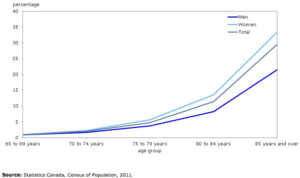By Michael Kary

In May of 2017, the latest Statistics Canada census figures for 2016 revealed that the country saw its greatest increase in the proportion of seniors. Like the rest of Canada, the statistics show that British Columbia now has many more seniors than children, with 18.3 per cent of B.C. residents 65 and over, compared to 14.9 per cent who are 14 and younger.[i] As the latest Statistics Canada data suggest, if current trends continue demand for residential care will only increase significantly in the future because the proportion of seniors living in care homes increases with age and the number of elderly seniors will grow as the aging of the population accelerates.
As Figure 1 below shows, about 1% of people between the age of 65 and 69 live in residential care homes in Canada, while the largest age group living in care-homes is 85 and older at 29.6%.[ii] The latest census data shows over 770,000 Canadians were aged 85 or older in 2016, with this cohort growing almost four times as fast as the overall population between 2011 and 2016. Data from the BC Ministry of Health also highlights that the growth in demand for health care for frail elderly living in residential care, who already utilize about 25% of health services, is projected to increase by 120% by 2036. Currently, this population accounts for almost $2.5 billion in health expenditures, including $1.9 billion in residential care and $380 million for hospital care.[iii]
| Figure 1: Percentage of Canadian seniors living in Residential Care (by Age Group) |
 |
In a 2015 report, entitled Future Care for Canadian Seniors: A Status Quo Forecast, the Conference Board of Canada estimated that by 2026 over 2.4 million Canadians age 65 and over will require continuing care support — up 71 per cent from 2011. By 2046, this number will reach nearly 3.3 million.[iv] The same report also highlights that the number of seniors living in a retirement home, supportive housing, or a long-term care home will grow to over 610,000 and that Canada will need an additional 131,000 spaces for Canadian seniors, growing to an additional 240,000 spaces by 2046. It is for these reasons, particularly with demand growing more rapidly than supply, that the Conference Board of Canada report advocates significant public and private sector investment in building the infrastructure that is necessary.[v]
With this increasing demand, as well as governments and stakeholders advocating for moving resources away from acute to home and community care (HCC) to reduce costs and improve quality care, it is somewhat troublesome to see other reports recommending that the role of the private sector in the delivery of seniors care be significantly diminished or reduced. This, for example, is seen most recently in a report released in March 2017 by the Canadian Centre for Policy Alternatives (CCPA) entitled Privatization and Declining Access to BC Seniors Care.[vi] While the BC Care Providers Association (BCCPA) is in general agreement with two of the three recommendations from this report, particularly relating to improving access to publicly funded HCC and developing a framework and action plan to improve access and service integration, the recommendation to significantly reduce the role of the private sector in HCC is entirely misguided.

In making this recommendation, the CCPA report argues that the quality of care provided in private care homes is largely inferior to that provided by non-profit and government run care homes. In particular, it also notes that staffing levels, including direct care hours (DCH), are lower as highlighted in a recent report from the BC Office of the Seniors Advocate (OSA).[vii] While the DCH levels may be lower in some private care homes, this assertion is somewhat disingenuous without also noting the DCH levels, whether private, non-profit or government run, are determined by the regional Health Authority, which provides funding for different DCH levels to each care home in BC. In reality, the number of daily care hours provided to seniors is mandated and closely monitored through a contractual agreement between the care provider and the health authority.
Likewise, along with failing to mention different DCH funding levels, the CCPA report also does not mention that all care providers, whether public, private or non-profit, are held to high-quality standards and regulations. Finally, and perhaps most importantly the CCPA report also relies largely on evidence from outside of province of BC or even Canada to argue that private run care homes provide inferior quality of care. Currently there is no specific BC data or studies which clearly highlights that private care homes provide inferior quality of care.
In fact, a recent report from Alberta which highlights results of a 2014/2015 Long Term Care Family Experience Survey largely debunks this notion indicating that in general, no one model type (government, private or non-profit) was better or worse than the others across all key measures of family experience measured.[viii] Similar to the Alberta study, the OSA is currently undertaking a comprehensive survey of residential care homes across BC to get a better understanding on the overall resident experience, so only then may it be more clear whether significant differences do indeed exist.
Not only is the CCPA report’s recommendation to diminish the role of the private sector in HCC misguided (as detailed further in the following BCCPA web post) if it were adopted it would have a very detrimental effect on access to seniors’ care across the province. This would be particularly problematic as private sector investment is critical to meet the needs of a rapidly growing and aging population. In summary, the private sector has and continues to play a crucial and important role in the delivery of seniors care in B.C. Currently, about 70 per cent of long-term residential care for seniors in British Columbia is delivered by non-government care providers. Removing these private providers out of our mix of care options is not only impractical, it would be costly and counterproductive.
Rather than pushing out private operators, the responsible position would be to embrace and encourage the types of innovation they have introduced into the system while upholding high standards for quality care.[ix] Such innovations include, for example, the introduction of new technologies but also development of large campuses of care which include a variety of amenities such as daycare centres or restaurants.
The BCCPA hopes to continue to discuss and highlight the important role the private sector plays in the delivery of seniors’ care, particularly as a leader in innovation and improving choice in all areas of the continuing care sector. The BCCPA also continues to support and uphold appropriate oversight and regulations so that care providers, regardless of ownership type, are held to the highest possible standards when it comes to caring for BC’s frail elderly. Along with communicating this to government and other stakeholders, the BCCPA hopes to have further dialogue on the role of the private sector in seniors’ care including possibly as a future topic area at one of our regular Care to Chat events.
END NOTES
[i] Statistics Canada. Age and sex, and type of dwelling data: Key results from the 2016 Census. May 3, 2017. Accessed at: http://www.statcan.gc.ca/daily-quotidien/170503/dq170503a-eng.htm?HPA=1
[ii] A Policy Framework to Guide a National Seniors Strategy for Canada. CMA. August 2015. Accessed at: https://www.cma.ca/Assets/assets-library/document/en/about-us/gc2015/policy-framework-to-guide-seniors_en.pdf
[iii] Setting Priorities for BC’s Health System. BC Ministry of Health. February 2014. Accessed at: http://www.health.gov.bc.ca/library/publications/year/2014/Setting-priorities-BC-Health-Feb14.pdf
[iv] CBC News. ‘We’re so far behind’: Canada unprepared for housing needs of rising senior population. Mark Gollom. May 5, 2017. Accessed at: http://www.cbc.ca/news/business/seniors-canadian-census-aging-home-care-1.4097293
[v] Greg Hermus, Carole Stonebridge, and Klaus Edenhoffer. Future Care for Canadian Seniors: A Status Quo Forecast. Ottawa: The Conference Board of Canada, 2015.
[vi] Canadian Centre for Policy Alternatives. Privatization & Declining Access to BC Seniors’ Care. March 2017. Accessed at: https://www.policyalternatives.ca/publications/reports/privatization-declining-access-bc-seniors-care
[vii] BC Office of the Seniors Advocate. British Columbia Residential Care Facilities Quick Facts Directory (2017). Accessed at: http://www.seniorsadvocatebc.ca/osa-reports/british-columbia-residential-care-facilities-quick-facts-directory-2017/
[viii] Health Quality Council of Alberta. Long Term Care Family Experience Survey Report: Provincial Results. October 2015. 2014/2015 Long Term Care Family Experience Survey
[ix] Vancouver Sun. Opinion: Private providers crucial to continuing care for B.C. seniors. Mike Klassen. October 23, 2016. Accessed at: http://vancouversun.com/opinion/opinion-private-providers-crucial-to-continuing-care-in-b-c




